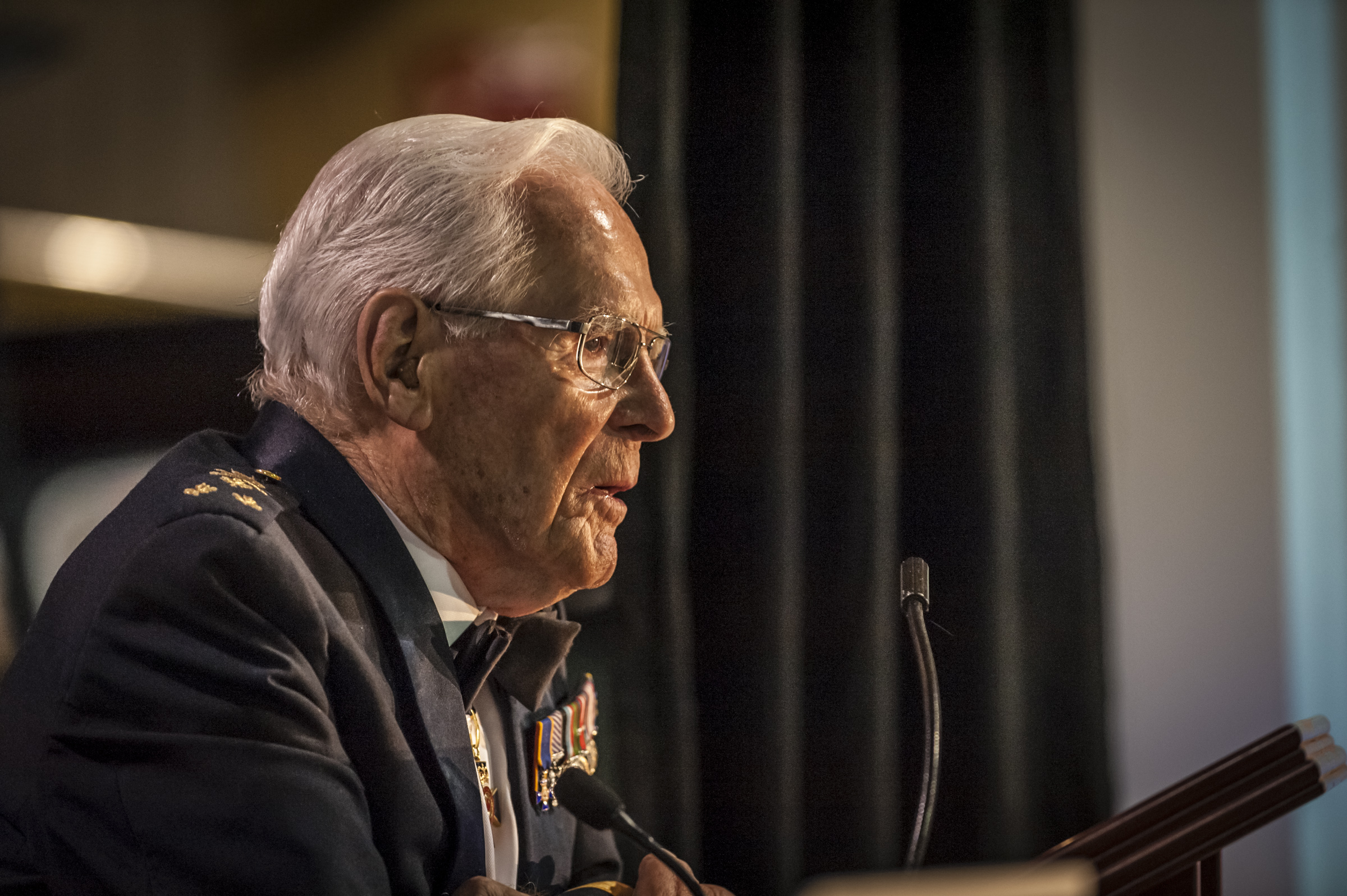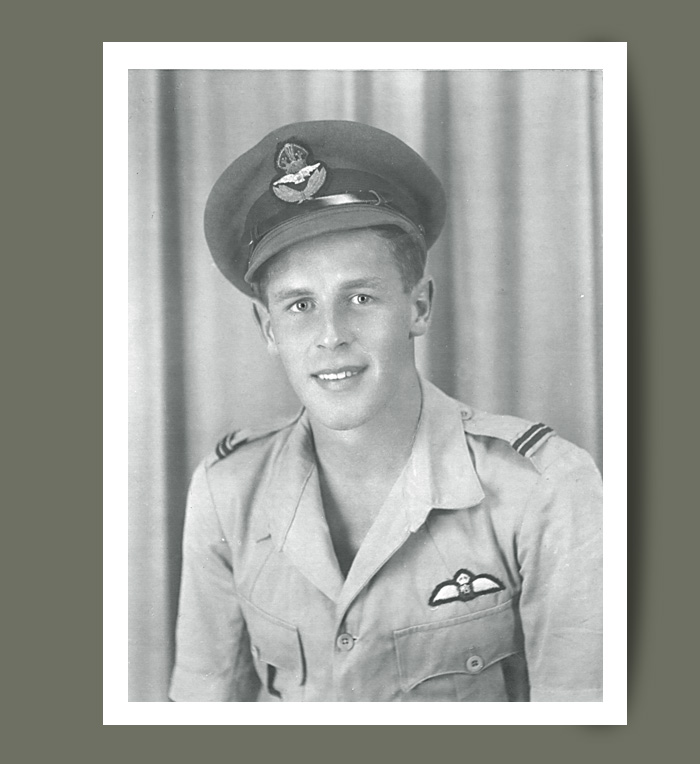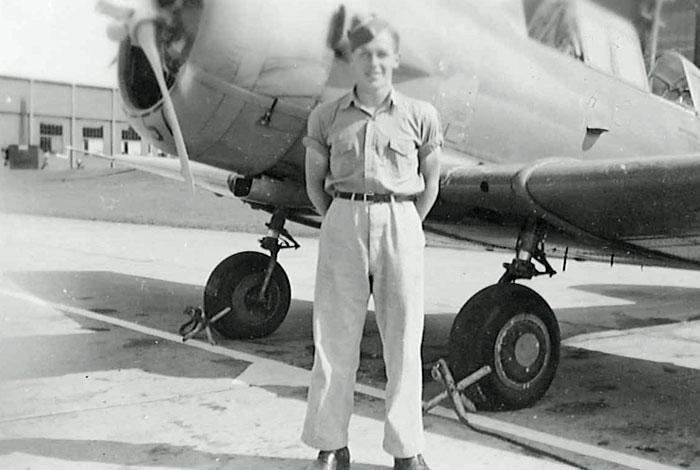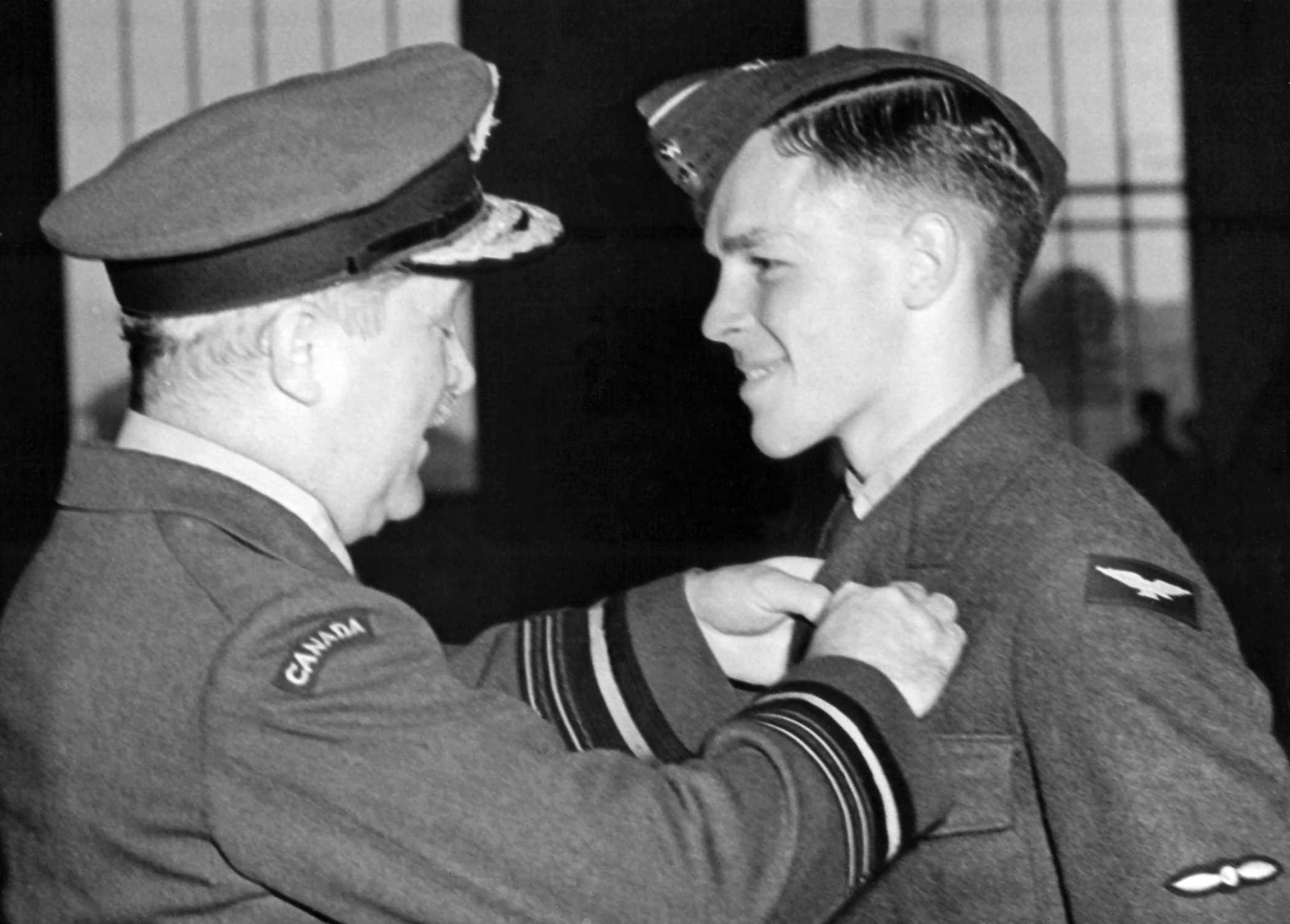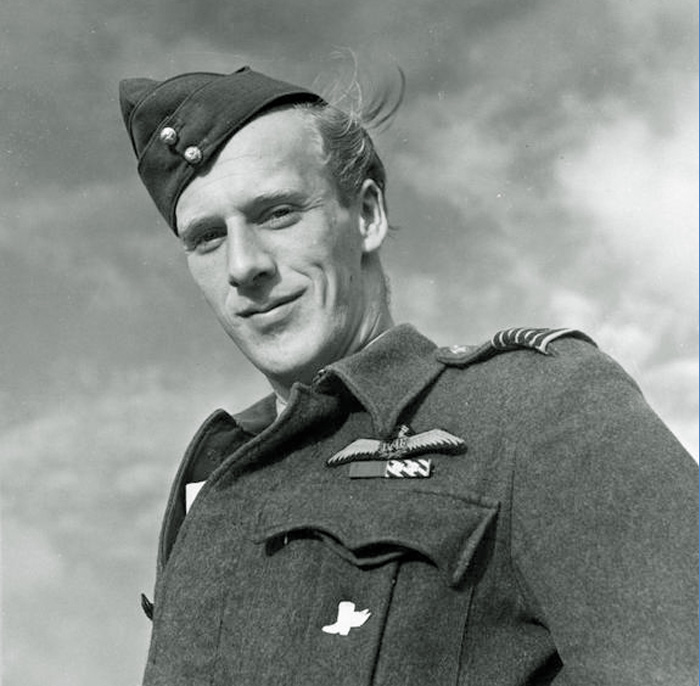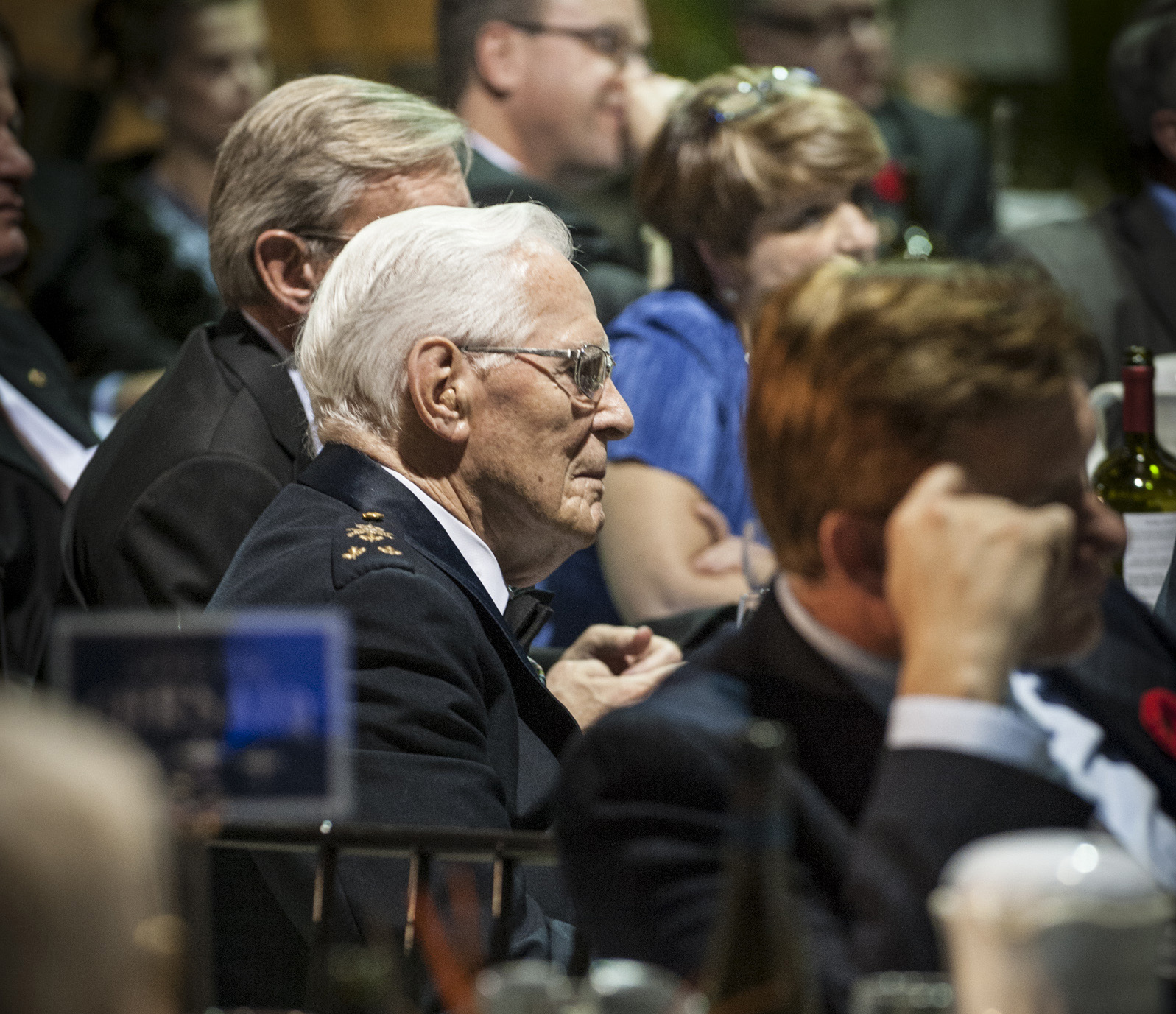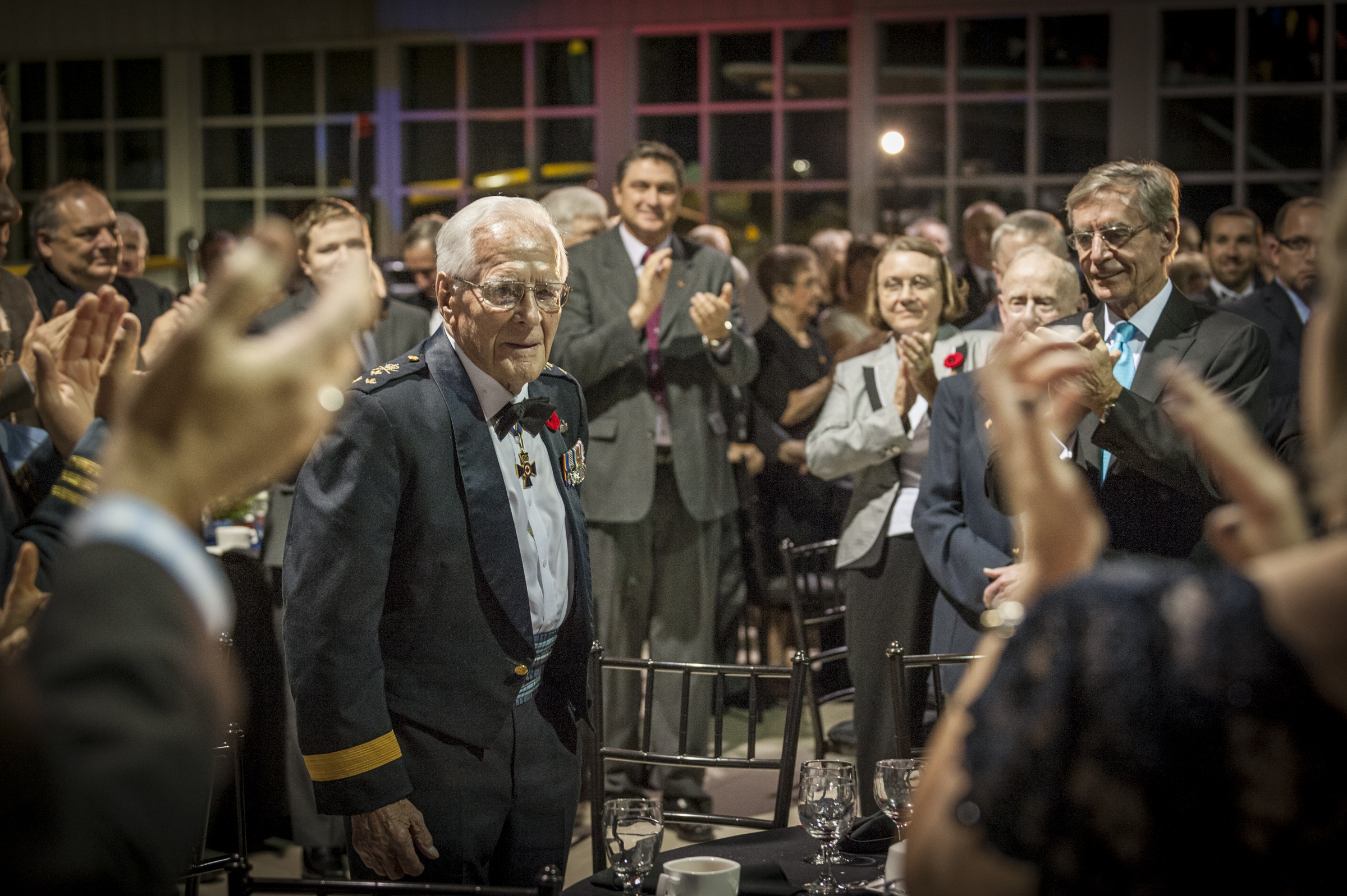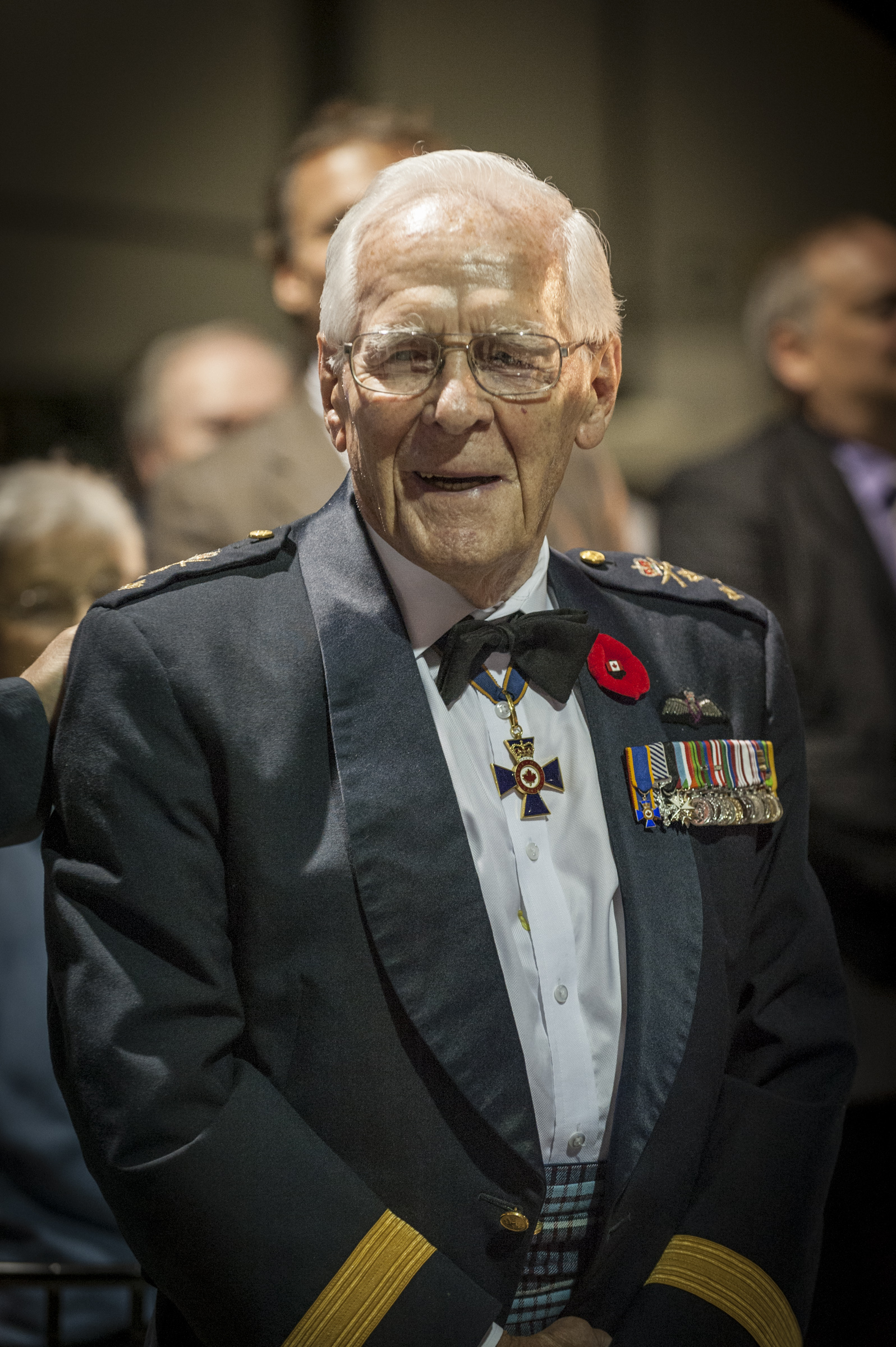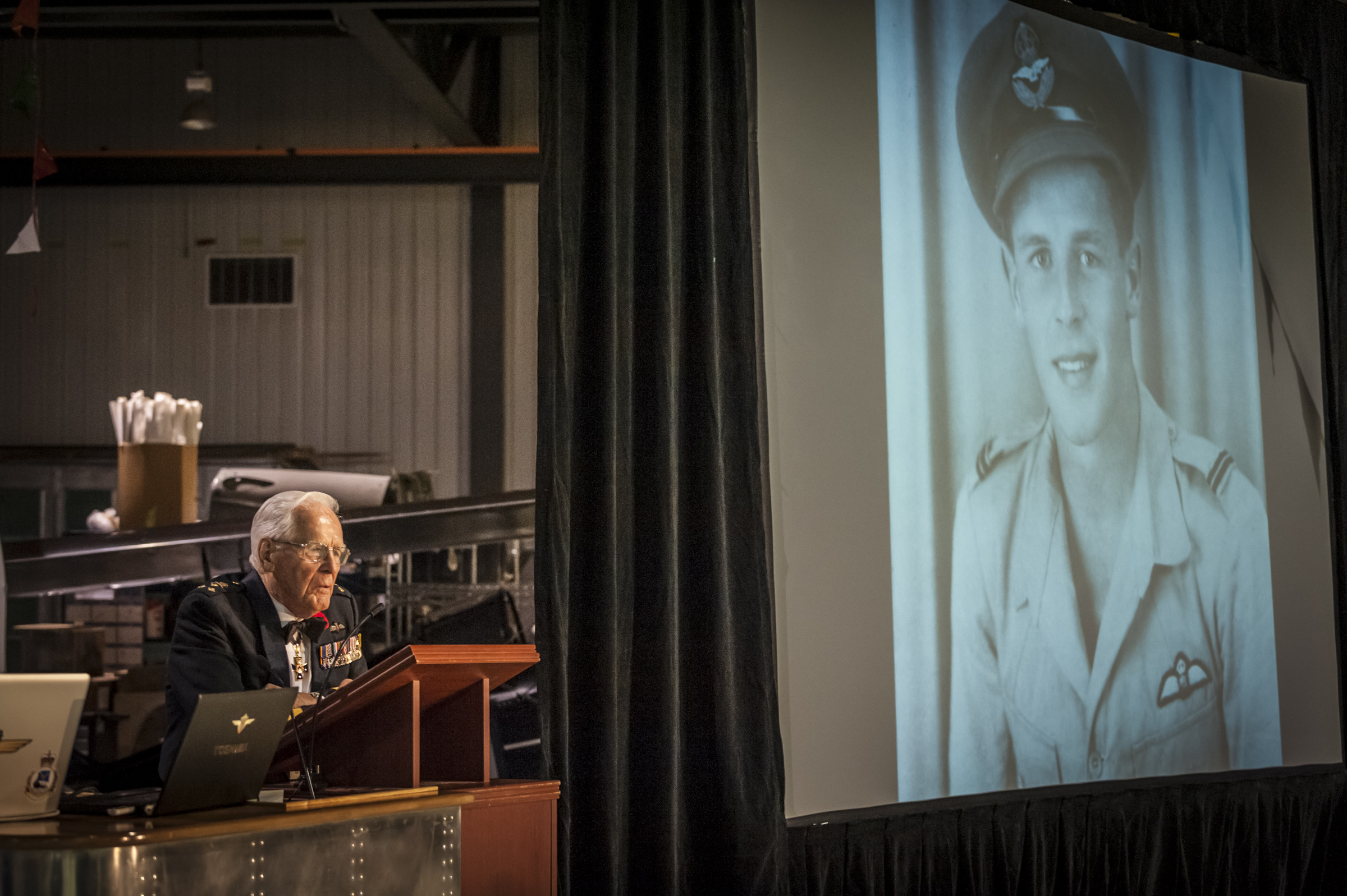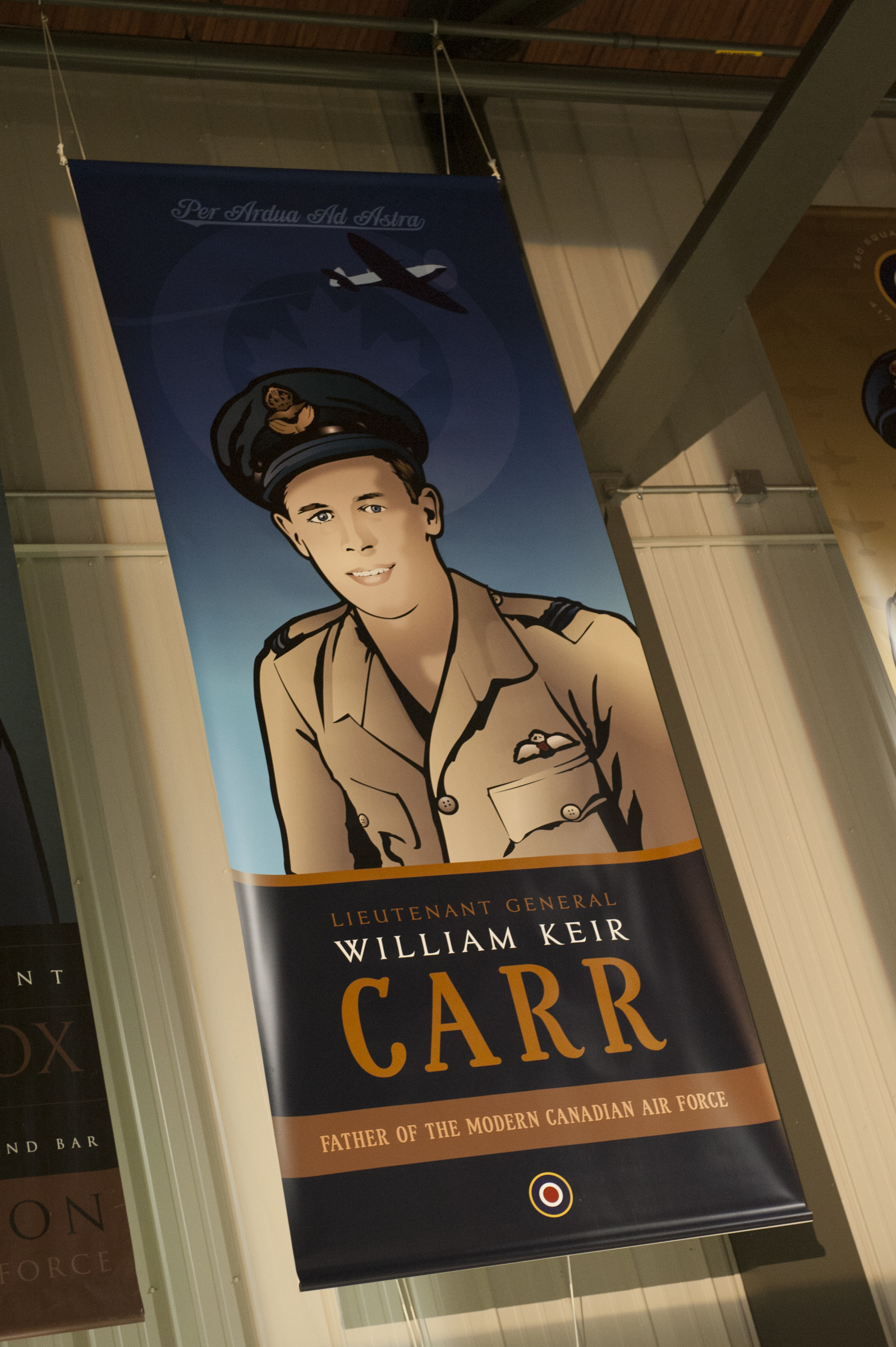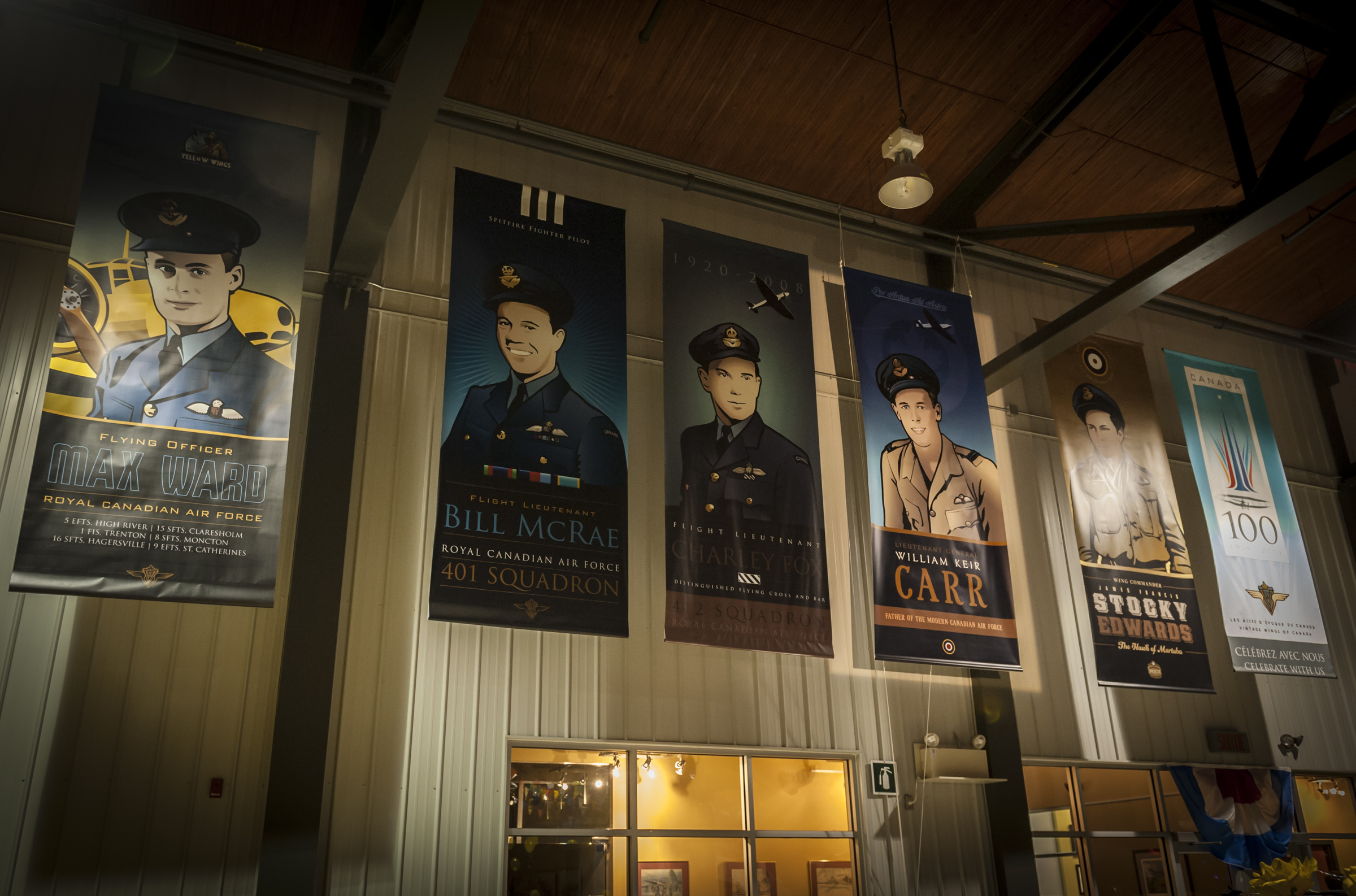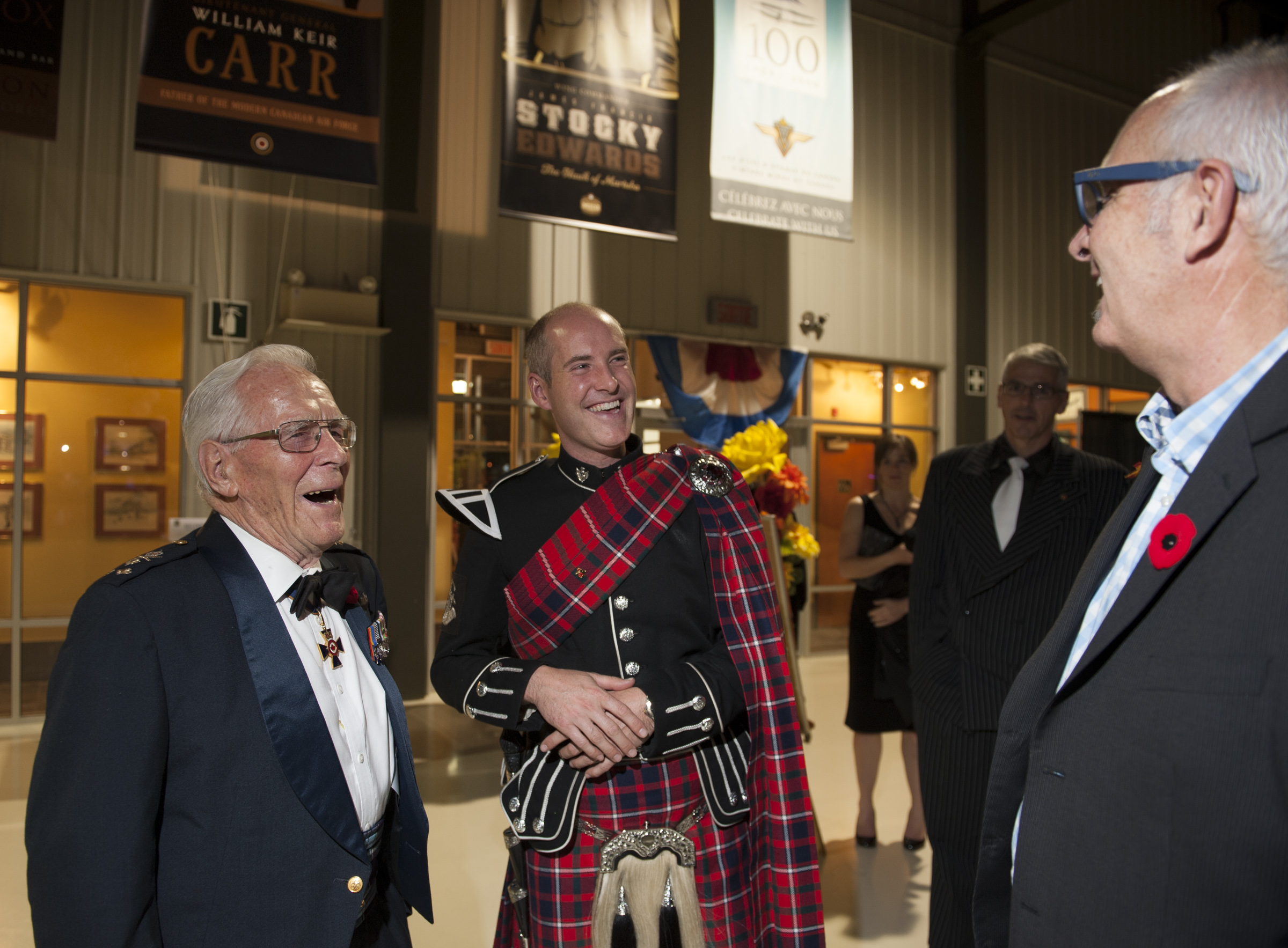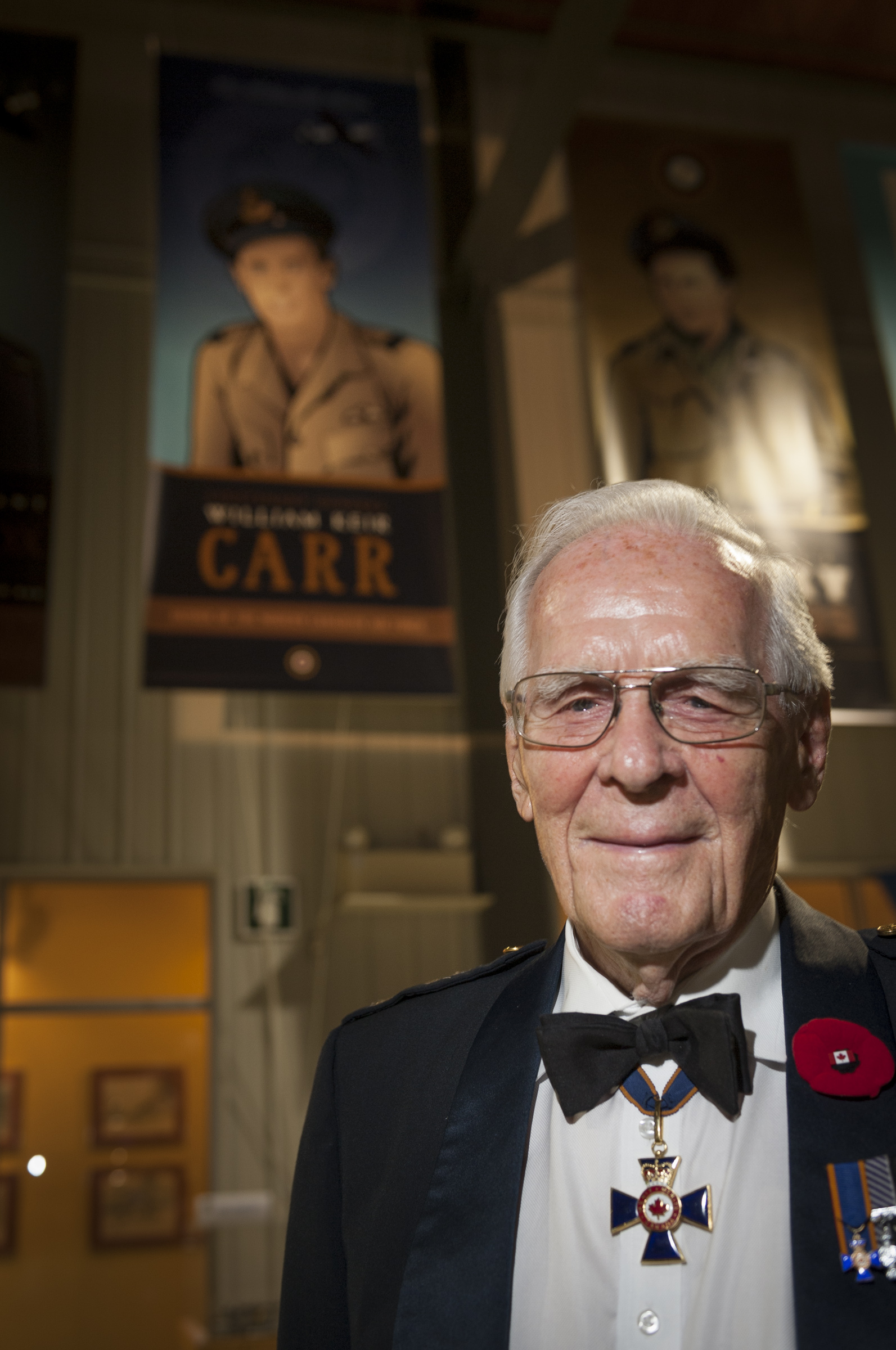Vintage Wings Canada honours Bill Carr, father of the modern Canadian Air Force
News Article / January 20, 2014
By Dave O’Malley, Vintage Wings Canada
On November 2, 2013, we had our Vintage Wings Victory Gala, celebrating our accomplishments of the past year. As is our tradition, we raise a banner honouring a living veteran pilot of the Second World War.
In past years, we have honoured men like Max Ward, Stocky Edwards and Bill McRae. This year, a year we celebrated leadership in all its facets, we paid a long overdue tribute to Lieutenant-General William Carr, a photo recon Spitfire pilot from the war.
Bill was on hand to see his image and name piped to the rafters in the Vintage Wings hangar in Gatineau, Quebec, alongside a pantheon of Canadian airmen – all of whom were his friends. Here is an edited version of the text of my speech honouring Bill.
Lieutenant-General William Kier Carr, Distinguished Flying Cross, Venerable Order of Saint John, Commander of the Order of Military Merit, Legion of Merit, Member of Canada’s Aviation Hall of Fame, was the first commander of Air Command, vice-president of Canadair and Bombardier and widely known as the father of the modern Canadian Air Force.
He was born in Newfoundland, before that province was part of Canada, the son of the manager of a fishery in the tiny fishing town of Grand Bank on the Burin Peninsula.
One of the photos we showed during the Vintage Wings gala was taken at a studio on the island of Malta in 1943. Bill’s mother had written to him there, asking him for a photograph. She must have been delighted by his image coming out of that envelope, but it must have surely brought tears to her eyes. I can just see her proudly showing it to all her friends in Grand Bank.
Bill was a photo reconnaissance Spitfire pilot with 683 Squadron, Royal Air Force. He flew a Spitfire equipped to fly fast, to fly high and to run from the trouble that it was a magnet for. It had no guns, no armour, and no bulletproof glass. Its only weapons were its cameras, its speed and the courage of young Mr. Carr.
That photograph of Mr. and Mrs. Carr’s beautiful son looks more like the young sons of 2013 than any image I have ever seen of an airman from the war. There is no weariness in his eyes, no tension in his jaw. He has made no attempt to look older with a moustache or more dashing with silk scarf. Despite the stress of continuous flying for two years, he is like an open book.
We’ve seen this boy before. He is your son; he is the boy who dated your daughter. He is the kid you said was going to go far.
My wife and I worried when our 20-year-old son drove alone at night to Toronto on the 401 highway. We begged him to call when he got there so we could sleep, knowing he was safe.
Mrs. Carr’s 20-year-old son would strap himself into a Spitfire and deliberately take it deep into a Europe run by Nazis, the greatest evil known to modern man. In broad daylight, he would fly over their encampments, their anti-aircraft installations, their factories, their cities, their airfields, travelling at 300 miles per hour, never positive that his oxygen system would continue to feed him life, or that his engine would continue to run in the thin air, always on the lookout for an attack.
He did this 142 times.
Mrs. Carr could never get a comforting call when her son got home safely. The best contact Mrs. Carr could hope for would be the odd handwritten letter coming from a place she had no idea he was in. The simple arrival of a single telegram at the Carr residence could induce terror enough to make her heart stop.
It was in this cauldron of anguish and menace, that the future leader known as the father of the modern Canadian Air Force was created from young Pilot Officer Bill Carr.
Bill Carr completed his Elementary Flying Training on Fleet Finches at No. 22 Elementary Flying Training School at L’Ancienne Lorette outside of Québec City. He did his service flying training on Harvards in Ottawa at No. 2 Service Flying Training School Uplands, flying Harvard 2866. That same aircraft is now owned by Vintage Wings Canada. His wings were pinned on him by no less a man than Air Marshal Billy Bishop.
He flew photo reconnaissance Spitfires deep into enemy territory from bases in England, Malta, and Italy.
For the three peaceful summers after the war, Carr and Bill McRae (whose banner also hangs in the Vintage Wings hangar) flew Norseman bush planes surveying the North of Canada. Although the work was challenging, it was perhaps the perfect way to decompress from years of hard flying and the deaths of so many friends. There was fishing, flying, camping and lots and lots of open skies for flying – with no enemy aircraft to ruin your day.
After the war, Carr continued to fly, did post-graduate work in chemistry and physics in the USA and attended staff college.
He continued to fly in the photo mapping business he learned so well in Malta and Italy – this time on Lancasters and Mitchells – until he became commanding officer of 412 Squadron at Uplands. It was here, on aircraft like the de Havilland Comet, the world’s first jet airliner, that he flew people like Her Majesty, Queen Elizabeth, Princess Margaret, French President Charles De Gaulle and Prime Minister John Diefenbaker.
After 412 Squadron, Carr moved up the command ladder in rapid steps – being promoted to the rank of group captain, commanding the United Nations air transport operation in the Congo, commanding RCAF Station Namao in Alberta, and the National Defence College, being promoted to air commodore, commanding Training Command as a major-general, going to NORAD Headquarters in Colorado Springs as chief of operations and – ultimately – being promoted to lieutenant-general and becoming as Deputy Chief of the Defence Staff.
His final leadership role was as the first commander of Air Command – an entity that he was responsible for creating in 1975.
He retired in 1978 after 36 years in the Air Force and went to work for 16 years as vice-president of International sales for Canadair and Bombardier.
I guess you could say that Mrs. Carr’s boy did pretty well.
In the end, Carr’s logbook totalled an astonishing 18,000 pilot flying hours – something very few military pilots can equal.
During the war, this great future air force leader had one of the finest role models imaginable in his commanding officer at 683 Squadron – Wing Commander Adrian Warburton, one of the most decorated RAF pilots of the war. Warburton was awarded no less than two Distinguished Service Orders and three Distinguished Flying Crosses!
From Wing Commander Warburton, young Carr learned about devotion to those under him. He learned that great leaders inspire loyalty, performance, respect and love.
I first head of Bill Carr from one of the de Havilland Comet pilots who he commanded at 412. Bob Fassold went on to become a major-general and surgeon-general of the Canadian Armed Forces.
I will leave the final word to Major General Bob Fassold, who personally saw, felt and benefited from the leader Carr was and is today and I quote
“He had very high and inspiring expectations and performance standards for all aircrew and squadron members,” said Major-General (retired) Fassold. “Consequently, we achieved such high levels on our own, that we not only took great pride in ourselves, but also in our 412 Squadron mates, and especially our [commanding officer].
“Carr seems then and still today to somehow quietly radiate competency and authority … and a high regard for the importance of everyone to the unit objectives. He never went around ‘commanding’… he just ‘did’… and clearly expected the same of you.
“Throughout his career, day in and day out, and to this day, he has set a glowing personal example of leadership in how to get things done right… sometimes even having to resort to unorthodox methods. In so doing he has contributed to the successes and enjoyment of life for so many.”
Vintage Wings Canada honoured Carr for his service to this country in war and peace and in business. Above all, we honoured Mrs. Carr’s beautiful son for his example of leadership that inspires us to this day.
If this was the National Hockey League, we would retire his jersey and raise it to the rafters.
The Vintage Wings equivalent was to raise a banner in his honour among a pantheon of Second World War heroes.
(Editor’s note: This article was originally published by Vintage Wings Canada on their website. It has been modified for length, and is translated and reproduced with permission.)
